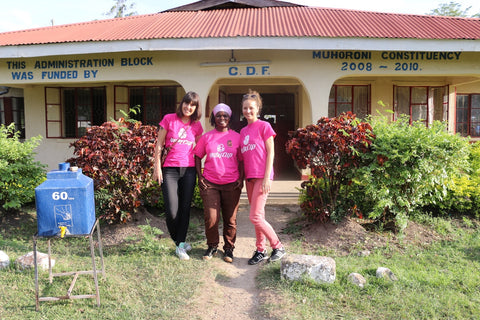In 2011, when we first started Ruby Cup and our Buy One Give One Programme, the “year of the period” was still three years ahead in the future and menstrual cups were not much of a trend yet.
The struggles with menstruation and the fact that girls and women worldwide miss school because they can’t afford healthy menstrual care products were still less known, which means there were not as many companies involved in donating menstrual products.
A lot has happened since, and we’re happy to see other menstrual product companies join us in the fight against period poverty by hosting Buy One Give One campaigns or making donations. But starting a Buy One Give One or One-for-One programme is not as easy as it sounds if you want to ensure that your goodwill won’t do more harm than good.
That’s why we want to share with you what it is that makes our programmes successful with an 80-90% adoption rate, and how we ensure that the girls and women who receive a Ruby Cup keep on using it with confidence and get to have 10 years of dignified, worry-free periods.
Building the base for a respectful, helpful and successful Buy One Give One programme
We started from scratch and knew that we wanted to do it right from the very beginning.
The first step was simply to listen and to learn. We studied the research and information that was already out there about the challenges of menstruation and how it affects girls and women from low-income families. We listened to the people affected by the issue and connected with local organisations that we could cooperate and potentially partner with.
Our partners, local organisations and locally based Ruby Cup Ambassadors and Trainers play a key role in making sure every Ruby Cup donation programme is carried out always with the long-term impact in mind.
They are the bridge between us, the providers of the product, and the girls and women receiving it. They are the experts in the field. They know and respect the communities that we work in and they are the ones capable of creating a trustful environment and a safe space for the girls to talk about their periods. A place, free from shameful attitudes towards menstruation, full of sound information, education and support.
We focus on sustainable partnerships and distributions with a long-term positive impact in mind
Currently, we run distribution programmes with trustful partners in eleven countries, among them Kenya, Tanzania, Uganda, Cameroon, Malawi, Benin, Ghana, Zambia, and Nepal. Our Social Impact Director, Amaia Arranz, always has the long-term positive impact at the forefront of all her work.
“What we mean with sustainable partnerships is that we want our distributions to have a long term positive impact in the lives of girls and women we work with. We provide the product, and yes it lasts 10 years, but we also provide education and support.
In our experience, if a girl receives training on how to use the Ruby Cup but also information on reproductive health when she gets her menstrual cup, it’s going to help her make good decisions in the long term.”
Amaia also says it’s crucial that each distribution includes a support system, someone who is there to create a safe space after the distribution, someone the girls trust and who is capable of answering all their questions when they start using the product.
“Just like anyone in the world who starts using a menstrual cup (or anything new in life); it takes some time to get used to it and to get the hang of it. Like myself, the first time I used my menstrual cup I couldn’t get it out - full disclosure- but I went online and I realised: Oh! Stop pulling and start pinching. So I had a resource to turn to that gave me this information. But very often the girls we donate to don’t have the same resources. So what we have to ensure is that they have access to the same support. And this is in the form of someone in the community - it could be a Ruby Cup Trainer, it could be a teacher, it could be another girl that has been using Ruby Cup for a while - but the girls that get a Ruby Cup need someone, who gives them this support during the first few months like we all need support.”

Our demand for the right infrastructure to be in place
Through the follow-ups, which are an obligatory part of our programmes, we have learned that the girls are more likely to keep on using their menstrual cup when sustained support is in place.
“If a mentor can go to a school every two weeks, that school tends to have a higher uptake than if she goes to the school every two months.”
One of our partners, the Golden Girls Foundation from Western Kenya, work with a team of mentors, who are experienced users themselves and always available to the girls.
“They’ll go to the schools and talk to the girls about reproductive health, menstruation, adolescent issues - which is always a very tricky part of life. And once these trainings have been done, they’ll give the cups to the girls. But these mentors will be available for questions, they’ll go back to the school, they’re part of the community. So if a girl has a question, she’ll know who to go to.”
Amaia mentions that having a support infrastructure in place is something that Ruby Cup demands from its partners and that it is the very reason why we work with locally based organisations. “You can’t just go there, hand out the cup and then leave, because then the sustained support won’t be there.” That infrastructure includes access to water for cleaning the cup and an understanding and respect for the local culture or community.
Just as the right infrastructure is obligatory, so is the fact that every trainer or mentor conducting an educational workshop during a Ruby Cup programme needs to be a menstrual cup user themselves. “You have to walk the talk”, Amaia says. It makes all the difference if the person teaching the girls about a menstrual cup believes in the product and has personal experience.
Why we involve the entire community in our Buy One Give One programmes
Community leaders, teachers and parents are all involved as widely as possible in the process of setting up a Ruby Cup programme. They have to be on board with the programme and open to the girls using a menstrual cup. Without this sensitization, the chance of a long-term positive impact is drastically low.
“It’s essential that when a girl goes home with her Ruby Cup that her mum is okay with her daughter using the cup. So what we find is that programmes tend to be more successful when the whole community is involved in this project of improving menstrual health for young girls.
So very often the introduction of Ruby Cup in a community starts with the adults. The men, the community leaders, the doctors, the teachers and so on. That is very important. And we have evidence that when the group where the girls receive the cup, has more access to support, the adoption rate is higher.”
_____
“It’s essential that when a girl goes home with her Ruby Cup that her mum is okay with her daughter using the cup.”
_____
When community leaders or teachers are first approached with our programmes, you might think they would be quite astounded as it might be the first time they hear of a menstrual cup.
Amaia explains that in places like Nairobi, it’s actually not a big issue, but that rural areas are more reluctant: “In Nairobi, a place where so many people are already using a cup and where we’ve been for eight years, most of them usually have already heard of it. They’re curious, but it’s nothing new. But sometimes, when we go to a rural area and they have never seen a cup before, they’re naturally more reluctant, because first, they want to know that the product is safe.”
Most of them want to see approval from doctors, they want to know if it has an impact on virginity and for how long it has already been used by others. That’s where it’s great for us to just show them that it’s the exact same product that we, the team behind the company use, and that it’s the chosen period product of thousands of menstruators around the world.
Amaia underlines the importance of patiently providing answers to all of their concerns and questions and being fully transparent. Once all doubts are addressed, most community leaders see that this is not about testing a new product but addressing a very essential need for the vulnerable girls and women in their community.
When asked if a collaboration was ever rejected by a community leader she says: “It’s not something that happens very often. But we had a case where an organisation based in a Western country wanted to implement a programme in an African country and then it turned out that the community centre that was based in the field said they didn’t want it. They didn’t want menstrual cups, and we said well, that’s fine we completely respect that and directed them to other sustainable solutions.”
Again, Amaia mentions that it’s something that doesn’t happen so often. “The reception is normally really good and so is the adoption rate. It’s at around 80% after a year of receiving the cup, but in schools that receive more visits from mentors it can go up to 90%. That’s why we’re so obsessed with the sustained support and the follow-ups. Because we know it’s the key to making sure the girls are happy using the cup.”
Ruby Cup is about being given the choice to use a menstrual cup
At every Ruby Cup programme, after the girls have participated in the educational workshop and learned how to use a Ruby Cup, they have the choice to take one home with them. They decide for themselves if they want to use one. “It would be completely incompatible with our values to say you have to use it because we like it or because we think that it’s the best solution.”
The Buy One Give One Menstrual Cup Movement - let this just be the beginning
It’s been six years since we started our Buy One Give One Programmes and we believe that the key to any successful programme is to involve everyone in the process. It’s important to give local NGOs and voices from within the community the space to be heard and to be the experts, because they are.
As the social enterprise that pioneered the Buy One Give One programme for menstrual cups and thinking back on how unknown and difficultly accepted the cup was when we started, we’re amazed and humbled everyday to see other companies and organisations join this movement and pushing dignified menstrual health into the public awareness.
The beauty of the Buy One Give One Programmes is that it connects all of us and makes us join forces. We’re walking this path together with strong partners and all of you Ruby Cup users who have purchased and donated and who have set their mind on changing the menstrual experience for the better.





